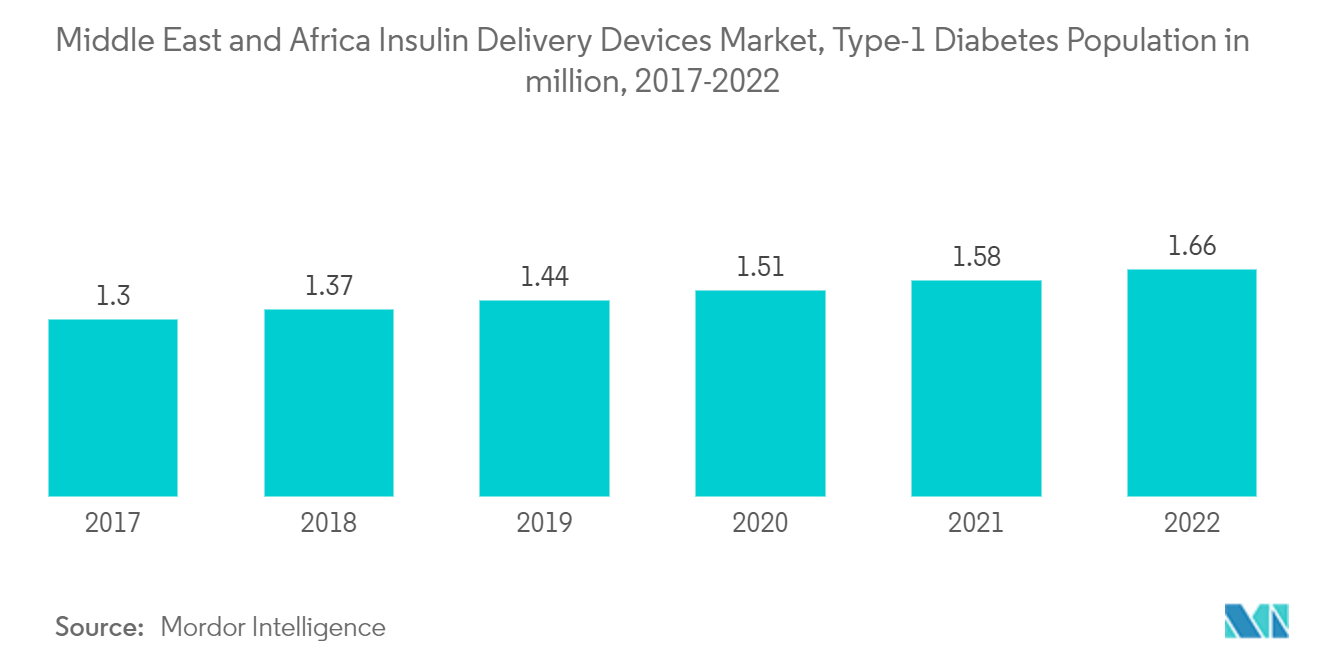Middle East And Africa Insulin Delivery Devices Market Size

| Study Period | 2017- 2028 |
| Base Year For Estimation | 2022 |
| Forecast Data Period | 2023 - 2028 |
| Market Size (2023) | USD 1.9 Billion |
| Market Size (2028) | USD 2.20 Billion |
| CAGR (2023 - 2028) | 2.99 % |
Major Players
*Disclaimer: Major Players sorted in no particular order |
Need a report that reflects how COVID-19 has impacted this market and its growth?
Middle East And Africa Insulin Delivery Devices Market Analysis
The Middle East and Africa Insulin Delivery Devices Market size is expected to grow from USD 1.90 billion in 2023 to USD 2.20 billion by 2028, at a CAGR of 2.99% during the forecast period (2023-2028).
The COVID-19 pandemic has substantially impacted the Middle East and Africa Insulin Delivery Devices Market. Type-1 diabetes patients are impacted more during Covid-19. People with diabetes are having a weak immune system so, with COVID-19, the immune system gets weaker very fast. People with diabetes will have more chances to get into serious complications rather than normal people. The manufacturers of Insulin delivery devices have taken care during COVID-19 to deliver insulin delivery devices to diabetes patients with the help of local governments. Novo Nordisk stated on their website that “Since the start of COVID-19, our commitment to patients, our employees and the communities where we operate has remained unchanged, we continue to supply our medicines and devices to people living with diabetes and other serious chronic diseases, safeguard the health of our employees, and take actions to support doctors and nurses as they work to defeat COVID-19.” Doctors around the world suggested diabetes patients should check their diabetes levels more often to be careful and the intake of medicine has increased, which lead to an increase in the usage of insulin delivery devices.
An insulin infusion pump works as an alternative to the traditional system of daily injections or an insulin pen. Insulin infusion pumps reduce the large swings in blood glucose levels, lessen pain, and deliver more accurately than injections. The scheduling of meal timings is not required when using pumps. This makes infusion pumps more user-friendly for patients. Insulin therapy is also known as continuous subcutaneous insulin infusion (CSII). It is an efficient and flexible method of insulin delivery.
Technological advancements have increased over the period in Insulin delivery devices for safer and more accurate administration of insulin. In 2021, Medtronic launched an Extended infusion set that leverages advanced materials that help reduce insulin preservative loss and maintains insulin flow and stability. The set is compatible with all MiniMed 600 and 700 series insulin pumps. The new tubing connector improves the physical and chemical stability of insulin, reliability of infusion site performance, and reduces the risk of infusion set occlusion. In addition to the new infusion set, the Medtronic Extended reservoir is also tested and approved to keep insulin stable and safely used for up to 7 days.
Therefore, owing to the aforementioned factors the studied market is anticipated to witness growth over the analysis period.
Middle East And Africa Insulin Delivery Devices Market Trends
The Insulin Pumps Segment is expected to witness the highest growth rate over the forecast period
The insulin pump segment is expected to register the highest growth rate of about 4.8% over the forecast period.
An insulin pump is a small battery-operated electronic device about the size of a pager or small mobile phone. The rapid-acting insulin is delivered via an infusion set that is inserted under the skin, i.e., subcutaneously. The device delivers insulin in two ways: basal (delivering small amounts of insulin continuously to maintain cell function) and bolus (delivering a dose of insulin on demand to account for the carbohydrates in meals or to correct high blood glucose levels). An insulin pump is worn 24 hours a day but can be taken off for up to two hours when required.
Data can be uploaded from insulin pumps via web-based software. The data relating to glucose concentrations and insulin delivery can be reviewed by the health professional with the patient. Randomized controlled trials have reported improvements in glycemic control using insulin pump therapy compared to multiple daily injections. These include reductions in blood glucose, reduced hypoglycemia, lower glycated hemoglobin, lower insulin requirements, and improved quality of life. Type-1 diabetic patients need to check their blood glucose levels at regular intervals, monitor their blood glucose levels, and adjust the insulin dosing accordingly to maintain optimum glucose levels in the body.
In the Middle East and African region, in recent years, the rate of diabetes has reached an all-time high, mainly due to lifestyle changes. Governments in the Middle East have identified the threat of diabetes and started to respond with various policies, initiatives, and programs. Six out of 15 countries in this region still do not have a national operational action policy for diabetes. Many countries still do not have a national strategy to reduce overweight, obesity, and physical inactivity, which are important risk factors for diabetes. Most counties have fully implemented national diabetes treatment guidelines. However, constant measures are being taken to minimize diabetic complications; therefore, owing to the aforesaid factors, the growth of the studied market is anticipated over the forecast period.

Iran is expected to dominate the Middle East and Africa Insulin Delivery Devices Market over the forecast period
Iran holds the highest market share in the Middle East and Africa insulin delivery devices market and is expected to register a CAGR of over 3.8% over the forecast period.
Diabetes is a serious public health concern in Iran, the Middle East's second-largest country, due to its high prevalence rate, growing occurrence rate, and economic impact. Diabetes-related mortality in Iran continues to rise; the age-standardized death rate from diabetes has risen throughout the years. Diabetes has significant economic consequences for the country. Diabetes, in addition to its high direct healthcare costs, is a significant risk factor for other chronic illnesses, such as cardiovascular disease.
Diabetes complications accounted for USD 412 (49%) of the USD 843 per capita cost of diabetes in 2021. Yazd, a world heritage city located in the center of Iran, has one of the highest recorded prevalences of diabetes mellitus in Iran. Other cities in Iran have varying levels of diabetes awareness. For example, in Kerman, a province south of Yazd, the prevalence of undiagnosed diabetes is only 2.7%, but it is 25% in northern Iran. Despite the widespread availability of drugs and insulin coverage in Iran, the estimated national control of hyperglycemia, hyperlipidemia, and hypertension (particularly among young men and women) remains inadequate.
However, the roll-out of many new products, increasing international research collaborations in technological advancement, and increasing awareness about diabetes among people are some of the market opportunities for the players in the market.

Middle East And Africa Insulin Delivery Devices Industry Overview
The Middle East and Africa insulin delivery devices market is moderately consolidated in nature due to the presence of only a few major companies like Novo Nordisk, Sanofi, Eli Lily and Company, Medtronic, Insulet, Ypsomped, Becton Dickinson & Company, etc. operating globally and other regional players.
Middle East And Africa Insulin Delivery Devices Market Leaders
Becton and Dickinson
Medtronic PLC
Novo Nordisk A/S
Sanofi Aventis
Eli Lilly and Company
*Disclaimer: Major Players sorted in no particular order

Middle East And Africa Insulin Delivery Devices Market News
- October 2022: Novo Nordisk announced headline results from the ONWARDS 5 phase 3a trial with once-weekly insulin icodec in people with type-2 diabetes. The ONWARDS 5 trial was a 52-week, open-label efficacy and safety treat-to-target trial investigating once-weekly insulin versus once-daily basal insulin (insulin degludec or insulin glargine U100/U300).
- October 2022: Becton, Dickinson, and Company and Biocorp announced that they have signed an agreement to use connected technology to track adherence to self-administered drug therapies, like biologics. To support biopharmaceutical companies in their efforts to improve the adherence and outcomes of injectable drugs, the two companies will integrate Biocorp’s Injay technology, a solution designed to capture and transmit injection events using Near Field Communication technology, with the BD UltraSafe Plus Passive Needle Guard used with prefillable syringes.
MEA Insulin Delivery Devices Market Report - Table of Contents
1. INTRODUCTION
1.1 Study Assumptions and Market Definition
1.2 Scope of the Study
2. RESEARCH METHODOLOGY
3. EXECUTIVE SUMMARY
4. MARKET DYNAMICS
4.1 Market Overview
4.2 Market Drivers
4.3 Market Restraints
4.4 Porter's Five Forces Analysis
4.4.1 Bargaining Power of Suppliers
4.4.2 Bargaining Power of Consumers
4.4.3 Threat of New Entrants
4.4.4 Threat of Substitute Products and Services
4.4.5 Intensity of Competitive Rivalry
5. MARKET SEGMENTATION
5.1 Type
5.1.1 Insulin Pumps
5.1.1.1 Insulin Pump Device
5.1.1.2 Reservoir
5.1.1.3 Infusion Sets
5.1.2 Insulin Syringes
5.1.3 Insulin Disposable Pens
5.1.4 Insulin Cartridges in Reusable Pens
5.1.5 Jet Injectors
5.2 Geography
5.2.1 Egypt
5.2.2 Iran
5.2.3 Oman
5.2.4 Rest of Middle East and Africa
5.2.5 Saudi Arabia
5.2.6 South Africa
6. MARKET INDICATORS
6.1 Type-1 Diabetes Population
6.2 Type-2 Diabetes Population
7. COMPETITIVE LANDSCAPE
7.1 COMPANY PROFILES
7.1.1 Novo Nordisk A/S
7.1.2 Sanofi
7.1.3 Eli Lilly and Company
7.1.4 Medtronic PLC
7.1.5 Insulet Corporation
7.1.6 Ypsomed
7.1.7 Becton Dickinson and Company
- *List Not Exhaustive
7.2 COMPANY SHARE ANALYSIS
7.2.1 Novo Nordisk A/S
7.2.2 Sanofi
7.2.3 Eli Lilly and Company
7.2.4 Other Company Share Analyses
8. MARKET OPPORTUNITIES AND FUTURE TRENDS
Middle East And Africa Insulin Delivery Devices Industry Segmentation
There are different ways to inject insulin into a patient’s body using syringes, pens, pumps, and jet injectors, giving them various options for insulin delivery. The Middle East and Africa insulin delivery devices market is segmented into type (insulin pumps, insulin syringes, disposable insulin pens, insulin cartridges in reusable pens, and insulin jet injectors) and geography (Egypt, Iran, Oman, rest of Middle East and Africa, Saudi Arabia, South Africa). The report offers the value (in USD million) and volume (in units million) for the above segments. Further, the report will cover a segment-wise breakdown (value and volume) for all the countries covered under the table of contents.
| Type | |||||
| |||||
| Insulin Syringes | |||||
| Insulin Disposable Pens | |||||
| Insulin Cartridges in Reusable Pens | |||||
| Jet Injectors |
| Geography | |
| Egypt | |
| Iran | |
| Oman | |
| Rest of Middle East and Africa | |
| Saudi Arabia | |
| South Africa |
MEA Insulin Delivery Devices Market Research FAQs
How big is the Middle East and Africa Insulin Delivery Devices Market?
The Middle East and Africa Insulin Delivery Devices Market size is expected to reach USD 1.9 billion in 2023 and grow at a CAGR of 2.99% to reach USD 2.20 billion by 2028.
What is the current Middle East and Africa Insulin Delivery Devices Market size?
In 2023, the Middle East and Africa Insulin Delivery Devices Market size is expected to reach USD 1.9 billion.
Who are the key players in Middle East and Africa Insulin Delivery Devices Market?
Becton and Dickinson, Medtronic PLC, Novo Nordisk A/S, Sanofi Aventis and Eli Lilly and Company are the major companies operating in the Middle East and Africa Insulin Delivery Devices Market.
Middle East and Africa Insulin Delivery Devices Industry Report
Statistics for the 2023 Middle East And Africa Insulin Delivery Devices market share, size and revenue growth rate, created by Mordor Intelligence™ Industry Reports. Middle East And Africa Insulin Delivery Devices analysis includes a market forecast outlook to for 2023 to 2028 and historical overview. Get a sample of this industry analysis as a free report PDF download.
